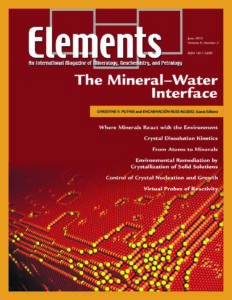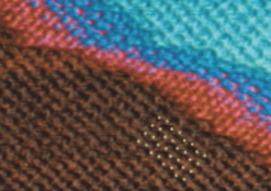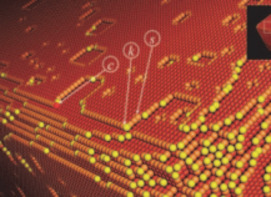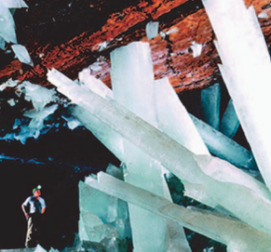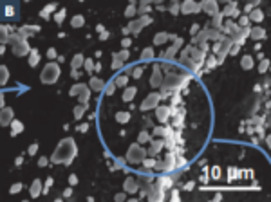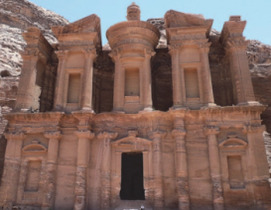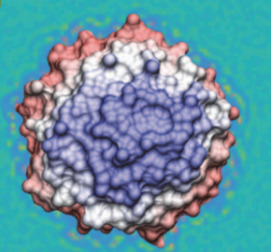
The Mineral-Water Interface
Christine V. Putnis and Encarnación Ruiz-Agudo – Guest Editors
Table of Contents
Reactions occurring at mineral–water interfaces are central to geochemical pro- cesses. They affect a wide range of important environmental issues, such as the composition of natural waters, weathering and soil formation, element cycling, biomineralization (including minor-element incorporation), acid mine drainage, and nuclear waste disposal. Recent studies using state-of-the-art spectroscopic and microscopic techniques have characterized the molecular structure of mineral surfaces, the distribution of fluids near surfaces, and dynamic processes such as dissolution, growth, and mineral replacement. These studies provide insights into the kinetics and mechanisms of reactions occurring at mineral surfaces, and they test the validity of predictions based on theory. These recent advances constitute the central theme of this issue of Elements. Modeling approaches used in mecha- nistic studies are also introduced. Such approaches complement direct, in situ, molecular-scale observations of processes occurring at mineral–water interfaces.
- The Mineral–Water Interface: Where Minerals React with the Environment
- A Stochastic Treatment of Crystal Dissolution Kinetics
- How Ions and Molecules Organize to Form Crystals
- Environmental Remediation by Crystallization of Solid Solutions
- Control of Crystal Nucleation and Growth by Additives
- Virtual Probes of Mineral–Water Interfaces: The More Flops, the Better!
AHF Analysentechnik
Applied Spectra
Bruker
Bruker Nano
Cambridge University Press
FEI
Excalibur Mineral Corporation
Geochemical Journal
Geochemist’s Workbench
Geological Society of London
IWA Publishing
JEOL
McCrone Microscope and Accessories
Rigaku
Savillex
SPECTRO
TSI
v9n4 CONTINENTAL CRUST AT MANTLE DEPTHS
Guest Editors: Jane A. Gilotti (University of Iowa)
The discovery of diamond and coesite in crustal rocks is compelling evidence that continental material has experienced pressures that can be achieved only at mantle depths. The classical idea that continents are too buoyant to subduct has given way to the notion of density changes driving deep subduction during the collision process, thus enabling some crust to be exhumed to the surface and the rest to sink into the mantle. Over twenty localities of unequivocal conti- nental crust containing diamond or coesite are now recognized around the globe, and their study constitutes a new field in petrology, dubbed ultrahigh-pressure metamorphism. Using microscopic observations, phase equilibrium modeling, geochronology, and geodynamic modeling, we track the journey of ultrahigh- pressure rocks to the mantle and back. Continental ultrahigh-pressure terranes impact our understanding of plate tectonics through time, crustal recycling and mantle geochemistry, melting in subduction zones, and collisional processes in general.
- The Realm of Ultrahigh Pressure Metamorphism Jane A. Gilotti (University of Iowa)
- Continental Crust at Mantle Depths: Key Minerals and Microstructures Hans-Peter Schertl (Ruhr University Bochum) and Patrick J. O’Brien (Potsdam University)
- Constructing the Pressure–Temperature Path of Ultrahigh-Pressure Rocks Hans-Joachim Massonne (University of Stuttgart)
- Linking Time to the Pressure–Temperature Path for Ultrahigh-Pressure Rocks William C. McClelland (University of Iowa) and Thomas J. Lapen (University of Houston)
- Deep Fluids in Subducted Continental Crust Jörg Hermann (Australian National University), Yong-Fei Zheng (University of Science and Technology of China), and Daniela Rubatto (Australian National University)
- Formation and Exhumation of Ultrahigh-Pressure Terranes Bradley R. Hacker (University of California, Santa Barbara), Taras V. Gerya (Swiss Federal Institute of Technology, Zürich), and Jane A. Gilotti (University of Iowa)
- One Hundred Years of Geochronology (February 2013)
- Serpentinites (April 2013)
- The Mineral-Water Interface (June)
- Continental Crust at Mantle Depths (August 2013)
- Nitrogen and Its (Biogeocosmo)Chemical Cycling (October 2013)
- Garnet: Common Mineral, Uncommonly Useful (December 2013)
Download 2013 Thematic Preview


